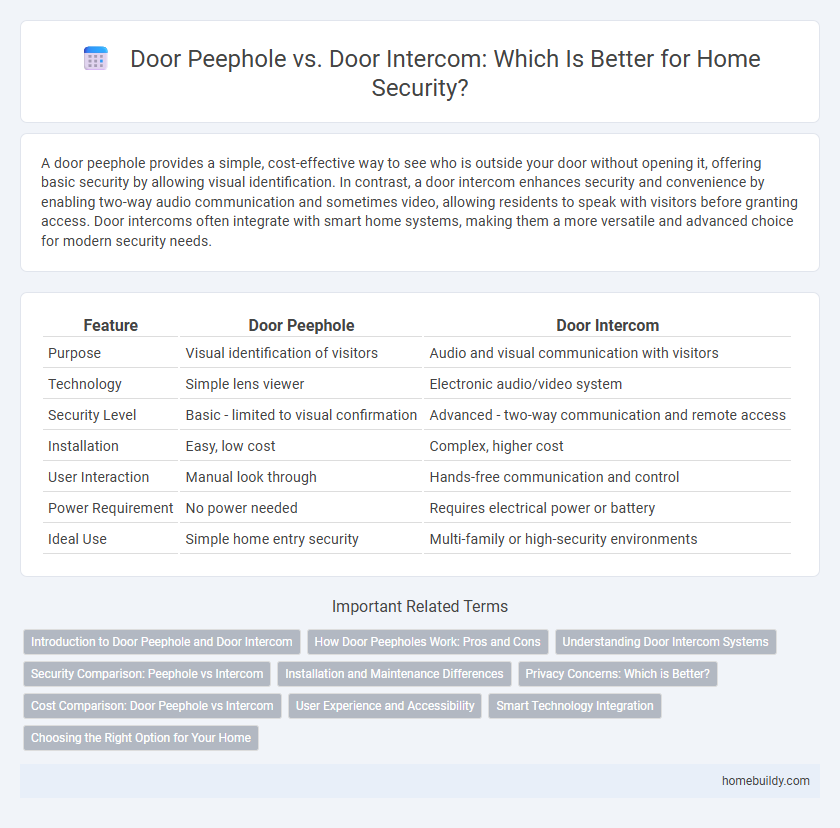A door peephole provides a simple, cost-effective way to see who is outside your door without opening it, offering basic security by allowing visual identification. In contrast, a door intercom enhances security and convenience by enabling two-way audio communication and sometimes video, allowing residents to speak with visitors before granting access. Door intercoms often integrate with smart home systems, making them a more versatile and advanced choice for modern security needs.
Table of Comparison
| Feature | Door Peephole | Door Intercom |
|---|---|---|
| Purpose | Visual identification of visitors | Audio and visual communication with visitors |
| Technology | Simple lens viewer | Electronic audio/video system |
| Security Level | Basic - limited to visual confirmation | Advanced - two-way communication and remote access |
| Installation | Easy, low cost | Complex, higher cost |
| User Interaction | Manual look through | Hands-free communication and control |
| Power Requirement | No power needed | Requires electrical power or battery |
| Ideal Use | Simple home entry security | Multi-family or high-security environments |
Introduction to Door Peephole and Door Intercom
Door peepholes provide a simple, cost-effective way to visually identify visitors through a small lens installed directly on the door, offering privacy and security without electronic components. Door intercoms enhance security by combining audio communication with video capabilities, allowing real-time interaction and remote access control. Both devices serve as entry-point security measures, with peepholes emphasizing passive observation and intercoms enabling active communication.
How Door Peepholes Work: Pros and Cons
Door peepholes function by using a convex lens to provide a wide-angle view of the area outside the door, allowing occupants to identify visitors without opening the door. They offer simple installation, low cost, and privacy protection but lack audio communication and remote monitoring capabilities found in door intercom systems. While door intercoms enable two-way communication and enhanced security features, door peepholes remain a reliable, low-tech option for basic visual verification.
Understanding Door Intercom Systems
Door intercom systems offer enhanced security by enabling two-way audio and video communication between visitors and residents, surpassing the limited visual scope of traditional door peepholes. These systems integrate with smartphones and home automation, allowing remote access control and real-time monitoring. Advanced door intercoms also feature motion detection and recording capabilities, providing comprehensive surveillance beyond the static view of a peephole.
Security Comparison: Peephole vs Intercom
A door peephole offers a basic level of security by allowing visual identification of visitors without opening the door, but it provides limited audio capability and no remote access. In contrast, a door intercom system enhances security by enabling two-way communication, remote monitoring, and integration with smart home devices, reducing the risk of unauthorized entry. While peepholes rely solely on direct line-of-sight, intercoms provide a more comprehensive security solution with greater control and convenience.
Installation and Maintenance Differences
Door peepholes require a simple installation process involving drilling a small hole in the door, making them quick and cost-effective to set up compared to door intercom systems that need electrical wiring and mounting of communication units. Maintenance for door peepholes is minimal, typically limited to cleaning the lens to ensure clear visibility, whereas door intercom systems demand regular checks of electronic components, wiring, and software updates to maintain functionality. The straightforward installation and low upkeep make door peepholes a practical option for residents seeking basic security without complex technical requirements.
Privacy Concerns: Which is Better?
A door peephole offers enhanced privacy by allowing residents to visually identify visitors without transmitting audio or video data beyond the door. Unlike door intercoms, which often connect to external networks or apps that may be vulnerable to hacking, peepholes eliminate risks associated with digital surveillance or data breaches. For individuals prioritizing privacy and minimal exposure, a traditional door peephole remains the superior choice.
Cost Comparison: Door Peephole vs Intercom
Door peepholes generally offer a low-cost security solution, with prices ranging from $5 to $20, making them an affordable option for basic visual identification. In contrast, door intercom systems, especially those with video capabilities, typically cost between $100 and $500 or more, reflecting advanced features and increased security benefits. Installation costs for intercoms are also higher due to wiring and technical setup, whereas peepholes require minimal to no professional assistance.
User Experience and Accessibility
Door peepholes offer a straightforward and low-cost solution for quick visual identification of visitors, enhancing user experience with simplicity and immediate access without relying on power sources. In contrast, door intercoms provide enhanced accessibility by enabling two-way audio communication, often with video capabilities, benefiting users with mobility or visual impairments through hands-free interaction. The choice between a door peephole and a door intercom depends on the balance between basic security needs and advanced accessibility features for diverse user requirements.
Smart Technology Integration
A door peephole offers basic visual identification through a simple lens, while a door intercom with smart technology integration provides enhanced security features such as real-time video streaming, two-way audio communication, and remote access via smartphone apps. Smart door intercom systems often include motion detection, night vision, and cloud storage, enabling efficient monitoring and control regardless of location. These advanced functionalities make door intercoms a more comprehensive solution for modern home security compared to traditional peepholes.
Choosing the Right Option for Your Home
A door peephole offers a simple, cost-effective way to identify visitors without opening the door, enhancing basic home security. In contrast, a door intercom provides two-way audio communication and often integrates video features, allowing homeowners to verify and communicate with guests remotely. Choosing between the two depends on factors like budget, desired security level, and convenience, with door intercoms suited for advanced security needs and peepholes for straightforward, low-maintenance use.
Door peephole vs Door intercom Infographic

 homebuildy.com
homebuildy.com